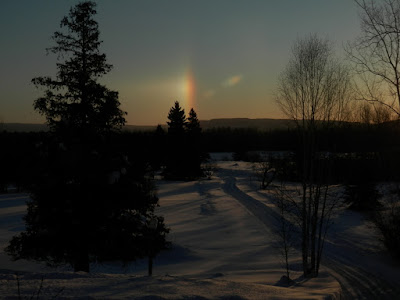 |
| Ski hill in distance is twice as far away as our atmosphere is thick |
That, of course, would be Homo erectus.
These hominids survived for two million years and eventually cohabited the Earth with several other human species including Homo neanderthalensis, Homo floriensis, Homo denisova and yes, Homo sapiens, the "wise one."
It wasn't the Neanderthals or the Denisovans that named us that. We thought up the "wise one" moniker ourselves. Homo sapiens have a lot of qualities but modesty isn't one of them.
Everybody got along in their respective regions: Asia, southwestern Europe, Indonesia, Siberia and East Africa.
Sapiens, who have been around for only 150,000 years, were much like the other hominids. They hunted and gathered and made fires just like the others had done for hundreds of thousands of years.
Then something went terribly "wrong" about 70,000 years ago. Sapiens streamed out of Africa and eventually killed everyone. In fact you could say we killed everyone and everything.
Our historical relationship with nature could be summed up with: "We ate the big ones first and then we ate the rest."
It is estimated our species has, at best, another 1,000 years.
So what happened 70,000 years ago? Author Yuval Noah Harari says in the book
Sapiens that is when the Cognitive Revolution started. People started believing in mythologies that eventually became religions, social hierarchies, systems of economics, corporations and countries. Things began snowballing downhill with the Agricultural Revolution 10,000 years ago and went ballistic with the Industrial Revolution, just 200 years ago. It is the latter revolution that will finish us along with most of the rest of life on the planet. It's one thing to have speared, shot and netted umpteen species into extinction but it is exponentially worse to pollute the very atmosphere everything breathes and alter the temperature of the entire planet so that nothing lives other than insects and bacteria.
That we can do this and not even care says everything about our species.We are arrogant, greedy, violent and conniving but that isn't even the worst about us. The worst is we believe in fantasies and refuse to accept reality when it conflicts with our beliefs. Case in point: How many people believe that those other humans mentioned above were steps on the evolutionary ladder that eventually led to the pinnacle of evolution - Sapiens! That fits with our mythology that we are the most intelligent and therefore the most deserving to be alive today and it helps us ignore the reality that if we are indeed "intelligent" we would not be exterminating all life.
Homo erectus walked the Earth from 2,000,000 years ago until 10,000 years ago. Our species started 150,000 years ago and will be gone at 151,000.
Must this be our outcome? No, it doesn't. We know as a species how to save the planet, how to live sustainably. There are real-world solutions. Our parents were called the Greatest Generation because they saved the world from Nazi tyranny through their hard work, sacrifice and ingenuity. Our generation needs to step up and save the world, period.
We are in a boat surrounded by a sea of uninhabitable space and we have continually been removing boards from the top of the boat. We're now down to the waterline.
Here's something to ponder: See that ski hill in the photo above? It is Mount Baldy as seen from our house in Nolalu. It is 36 miles away. That is exactly twice as far as the thickness of our atmosphere.
It is just 18 miles high. Now do you understand how easy it is to pollute it, to change its composition?
When we look up at the sky it seems endless because there is nothing on the other side. It is anything but. It is a thin, fragile veneer and it is the only thing that supports Life.























